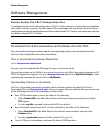
8
Enhancements in Release F.05.05 through F.05.70
Enhancements in Release F.05.05 through F.05.60
MIB (Management Information Base): An internal database the switch maintains for configuration
and performance information.
Neighbor: See “LLDP Neighbor”.
Non_LLDP Device: A device that is not capable of LLDP operation.
TLV (Type-Length-Value): A data unit that includes a data type field, a data unit length field (in
bytes), and a field containing the actual data the unit is designed to carry (as an alphanumeric string,
a bitmap, or a subgroup of information). Some TLVs include subelements that occur as separate data
points in displays of information maintained by the switch for LLDP advertisements. (That is, some
TLVs include multiple data points or subelements.)
General LLDP Operation
An LLDP packet contains data about the transmitting switch and port. The switch advertises itself
to adjacent (neighbor) devices by transmitting LLDP data packets out all ports on which outbound
LLDP is enabled. (LLDP is a one-way protocol and does not include any acknowledgement
mechanism.)
Packet Boundaries in a Network Topology
■ Where multiple LLDP devices are directly connected, an outbound LLDP packet travels only to
the next LLDP device. An LLDP-capable device does not forward LLDP packets to any other
devices, regardless of whether they are LLDP-capable.
■ An intervening hub or repeater forwards the LLDP packets it receives in the same manner as any
other multicast packets it receives. Thus, two LLDP switches joined by a hub or repeater handle
LLDP traffic in the same way that they would if directly connected.
■ Any intervening 802.1D device, or Layer-3 device that is either LLDP-unaware or has disabled
LLDP operation, drops the packet.
LLDP Configuration Options
Enable or Disable LLDP on the Switch. In the default configuration, LLDP is globally enabled
on the switch. To prevent transmission/reception of LLDP traffic, you can disable LLDP operation.
Transmit Mode. With LLDP enabled, the switch periodically (30 second intervals) transmits an
LLDP advertisement (packet) out each active port enabled for outbound LLDP transmissions. You
can enable or disable LLDP packet transmissions on a per-port basis. If a port is disabled, the switch
does not use the port to inform LLDP neighbors of its presence.
The following table lists the information the switch includes in the per-port, outbound LLDP packets
it generates. In the default configuration, all outbound LLDP packets include this information in the
TLVs transmitted to neighbor devices.


















